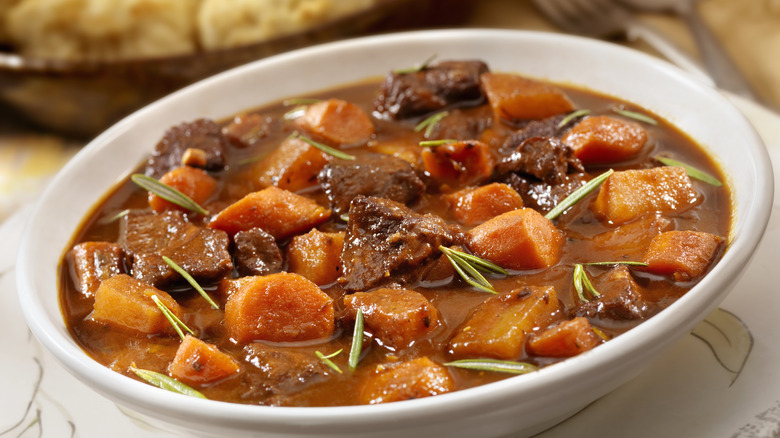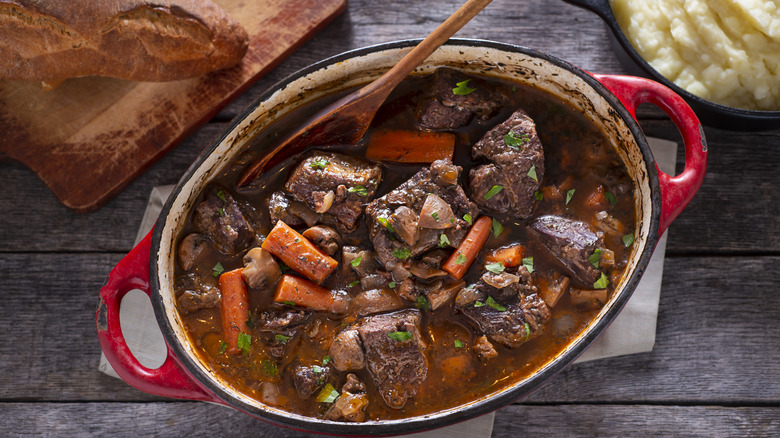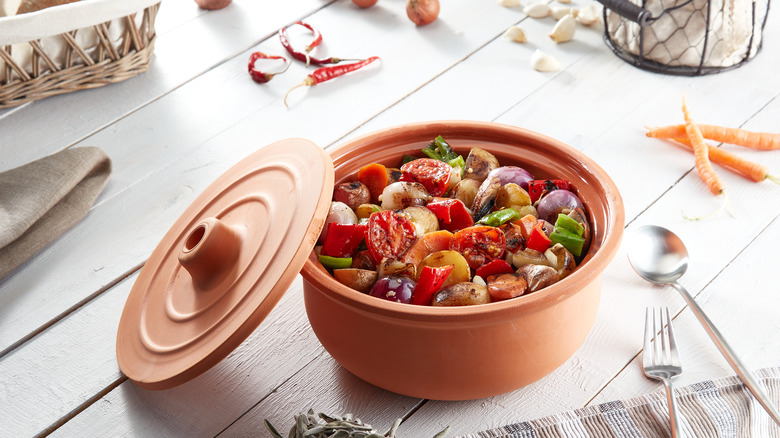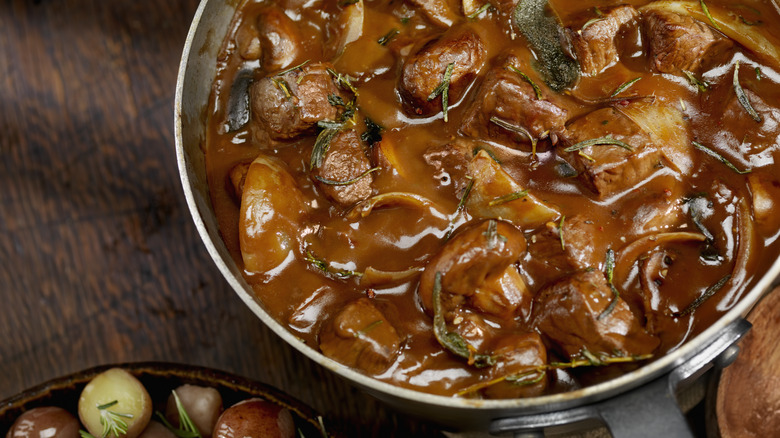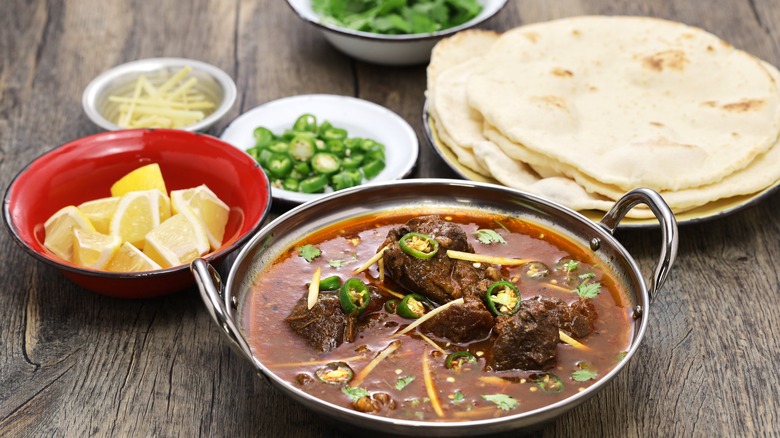What's The Difference Between Beef Bourguignon And Beef Stew?
There's a special satisfaction to be found in a beef stew, especially for meat lovers. Savory, filling, and warming, it's an ideal dish for the long wintery nights. And although you might be most familiar with the delicious old-fashioned beef stew packed with potato and carrots, the dish offers far more range.
The notion of cooking — and simultaneously tenderizing — beef over slow heat is deeply ingrained in our culture. During the 18th century, a reference to bathhouses and brothels gave stew its rather risqué name. However, its creation runs back centuries further, even including a mention in the Old Testament.
A particularly famous and mouthwatering type of stew is the French beef bourguignon. Hailing from Burgundy, it's a version of the dish that's so iconic many forget it's an interpretation. Yet, its 20th-century spike in popularity evinces beef stew's perennial nature. Plus, exploring its distinction among a breadth of beef stew dishes showcases the style's expansive nature.
What is beef bourguignon?
Beef bourguignon starts with many common stew components: Onion, carrot, garlic, and flour. From there, a few ingredients fundamental to the dish are added: Sweet and small pearl onions, mushrooms, a pork fat base, and, perhaps most importantly, wine. Added seasonings including garlic, thyme, bay leaf, and parsley are quintessentially French. The melding of pork fat, wine, and tissue-rich beef makes beef bourguignon shine.
The dish descends from a long-standing tradition of French stews dating back to the Middle Ages. Back then, meat was slow-cooked over a hearth, giving rise to preparations like crowd-pleasing pot-au-feu. Bourguignon's wine-based richness didn't come along until later. Stewed dishes cooked with cured pork, wine, mushroom, and onions — a style called "a la bourguinotte" — were first documented during the 19th century. Renditions started with proteins other than beef; in print, an eel base predated meat.
It wasn't until the 1903 publication of Auguste Escoffier's recipe that beef bourguignon became a hit. From there, the dish quickly spread among upscale restaurants in Europe. Several decades later, Julia Child's accessible recipe further cemented the dish as a French classic popular worldwide.
What is beef stew?
Beef stew has taken on many different forms over the centuries. According to archaeological evidence, slow-simmered meats were enjoyed by civilizations in the Middle East, Vikings, and Romans. The first recipe for a beef stew with a ragout-like composition appeared in print during the 14th century. Since then, beef stew recipes have evolved across global cuisines, making it a complex dish to encapsulate under one umbrella. However, there are a few unifying factors.
Slow cooking is key, whether the stew is prepared in the oven, on the stovetop, or over coals. Time melds together components, simmers down the liquid, and tenderizes the beef, which is crucial. Stewing is basically a vessel for cooking tougher cuts of meat — so you won't want to toss a nice steak into the pot. Instead, cuts full of cartilage and bones are essential; the protein, fat, and connective tissue cook down, thereby thickening the dish.
Paired flavors vary, but there are some dependable complements. Nearly every type of onion can be employed, which provides a sweetness and aroma that mingles with the beef. Typically a bright spice or vegetable mix can be used to contrast the meat's richness. Cooks also throw in umami-laden ingredients like varying ferments, soy, or Worcestershire sauce to elevate savouriness. Meld all components together, and a delicious beef stew emerges.
Unlike other stews, beef bourguignon uses wine
Especially if it's your first go around, you'll need lots of tips when making beef bourguignon. It's a complex dish that takes time — but it all rests upon the foundational flavor of wine. The drink's tannins meld with the stew's fat, creating a bold flavor greater than the sum of its parts. Plus, the alcohol aids in tenderizing the beef, with some chefs pre-marinating meat chunks for several hours.
With the dish's Burgundy origins, it's fitting that the region's red wine is utilized. The booze should be tasty and fit for drinking on its own, but there's no need to reach for top-shelf stuff. As the cooking goes along, the less appetizing attributes of the wine are diminished. Unlike other stews, the wine is the sole liquid cooking component.
Additional components like fatty cured pork, mushrooms, and pearl onions are essential, but the pairing of wine and beef defines the dish, making it a standout in the stew repertoire.
Beef stews can be found throughout the world
While undeniably tasty, beef bourguignon is just one of many beef stew variations. The traditional beef stew varieties popular in America largely stem from a European tradition, borrowing from France, Britain, and Ireland. On the Emerald Isle stout is added for a traditional Irish stew flavor.
Combined with other influences, an array of beef stew styles exist stateside. Chili is technically a stew, with everything from Texan red chili to a classic Midwest riff to sample. Then there's burgoo, with a history intertwined with the Kentucky Derby.
The cooking method is also popular in Mexico, where the flavor of the sauce, rather than the meat, gets the focus. Popular examples include richly flavored birria and carne guisada, a dish with large chunks of beef cooked with peppers and potatoes.
Braising is a popular technique in China, making beef stews part of the culinary repertoire. Such dishes integrate aromatics and spices while pairing beef with root vegetables like radishes and turnips. For an even more fragrant beef stew variant, there's Pakistani Nihari, which uses beef bones to make a rich, spiced broth. Asian influences also coalesce in Jamaican beef stews, which brown meats for caramelization before turning to vinegar, spices, and chilies for a bold flavor. Many other beef stews exist elsewhere, showcasing the expansive and delicious potential of the preparation style.
